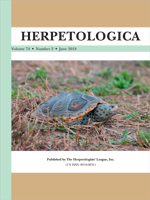Malaclemys terrapin inhabits salt marshes of the coastal United States and has been historically divided into seven subspecies. Two of the described subspecies, M. t. pileata and M. t. littoralis, occur along the western and eastern coastlines of Louisiana, respectively. To better understand potential boundaries of these two subspecies, we documented pigmentation variation of the plastron along the coast of Louisiana where the subspecies supposedly intergrade. Photographs of the plastron were taken of captured individuals and we quantified pigment with a photoprocessing software (ImageJ). We found pigmentation differences between sexes, with females having lighter plastrons than males. The plastron pigmentation of females decreased with increasing plastron length, whereas that of males varied by site but not length. Plastron pigmentation did not correlate with longitude in either sex, indicating that there is no geographical cline in this trait. We suggest that large females might be released from the predation pressure of gape-limited predators, and therefore, can stop production of melanin as they grow. However, males and smaller females maintain cryptic, dark plastrons. Little is known about the mechanisms behind melanization in freshwater turtles, but understanding the patterns of pigmentation variation in M. terrapin might be important for taxonomists and conservation managers.
How to translate text using browser tools
1 June 2018
Plastron Pigmentation Variation in a Coastal Turtle Species of Conservation Concern (Malaclemys terrapin)
Beth Reinke,
Steven Pearson,
Will Selman
ACCESS THE FULL ARTICLE

Herpetologica
Vol. 74 • No. 2
June 2018
Vol. 74 • No. 2
June 2018




